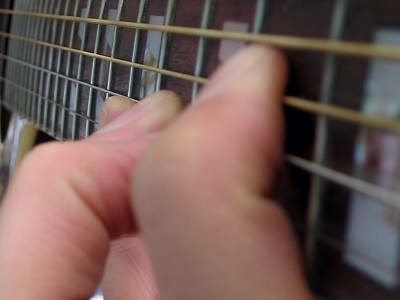Major 9th Guitar Chords – Reference And Learning
 The classification of extended chords can be a little tricky and confusing to novice guitarists. The Major 9th guitar chord is no exception.
The classification of extended chords can be a little tricky and confusing to novice guitarists. The Major 9th guitar chord is no exception.
It is not so confusing to voice the chord or recognize it in music, once you know how it is formed, and what its notation is. Major 9ths are often used in Funk, and rarely in Rock or Metal.
This is because of the slight dissonance and complexity of the chord, which does not lend itself to the raw, power chord dominated music styles.
It is also best played with a clean guitar sound, so don’t use a distortion pedal when learning it, or experimenting with other extended chords.
Formation of Major 9th Chords
The Major 9th is fairly easy to map out if you are familiar with your basic major and minor triads. It is made up of a major triad, with a major seventh and ninth note added. This chord is slightly different to a Dominant 9th chord, which will have a flattened 7th note, since the Dominant 7th is formed with a major triad, with a minor seventh added.
If the ninth chord does not have the word “major”, or the symbol “M” preceding its description or notation, then it is implied that the Seventh Chord is a Dominant 7th, with an added ninth note.
The formula for a Major 9th chord is as follows: root, major third, fifth, major seventh, ninth. The guitar notation is 1, 2 ,3 ,5 ,7 , 9. When playing the Major 9th chord on a guitar, it is quite normal to leave out the fifth note, or dominant.
This is because it is not essential to the distinct tone of the chord, and playing a five-note chord on the guitar is not only tricky, but the sound becomes a bit muddy. The same convention applies to playing Major, Minor and Dominant 7th chords.
A simple way of picturing a Major 9th chord on the fretboard is to form a Major Seventh, then add a minor third note onto the seventh note.
Major 9th guitar chords are notarized by the key, followed by a capital “M”, then the number “9”. Thus, a Ninth Chord in C Major will appear as : CM9.
Practical Usage of the Major 9th Guitar Chord
In Jazz and Funk, it is common to use only a couple of voicings for Major Ninth guitar chords. Many guitarists will only concentrate on the top three notes, namely the third, seventh and ninth. When choosing the voicing you want to use, try and avoid chord shapes with the root of the Major 9th chord on the sixth string, or playing them on the low frets; this can result in a very muddy tone, something that negates the leading quality of the ninth chord.
Rather position your Major 9th chords fairly high up the neck of the guitar, and place emphasis on the top three, or even just the top two strings, depending on the voicing. The Major 9th guitar chord is great for practicing Funk rhythms.
You should try using both palm and string muting, and mix in some Wah-pedal techniques. Start off slow and make sure that the chord is played correctly, so none of the strings buzzes, then gradually increase your strumming tempo, before integrating the Wah-pedal.







Leave A Comment